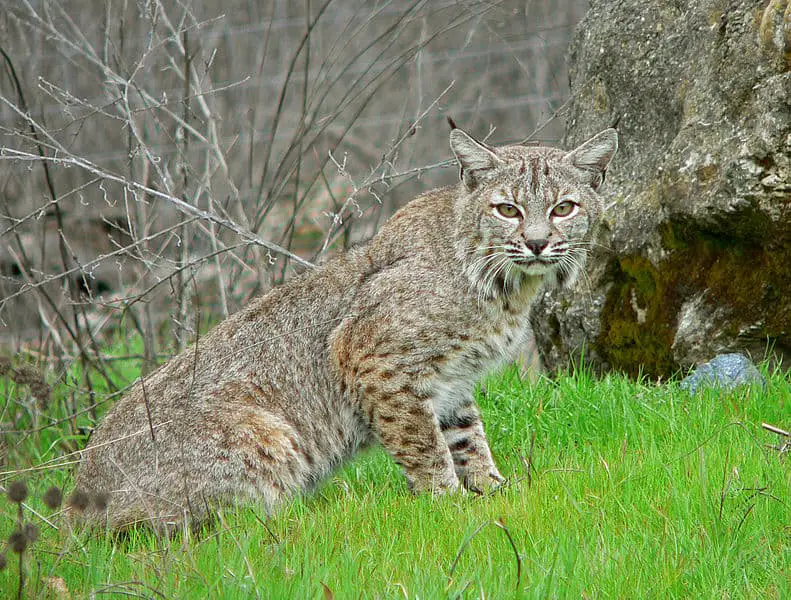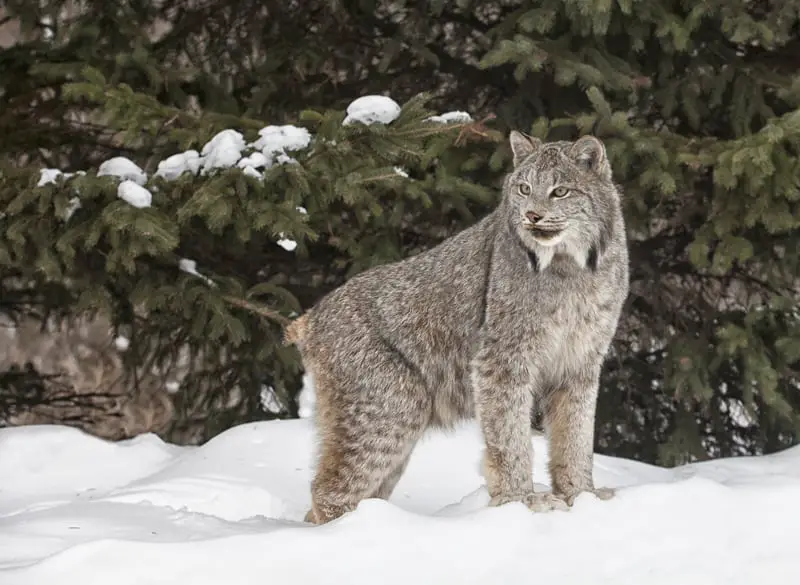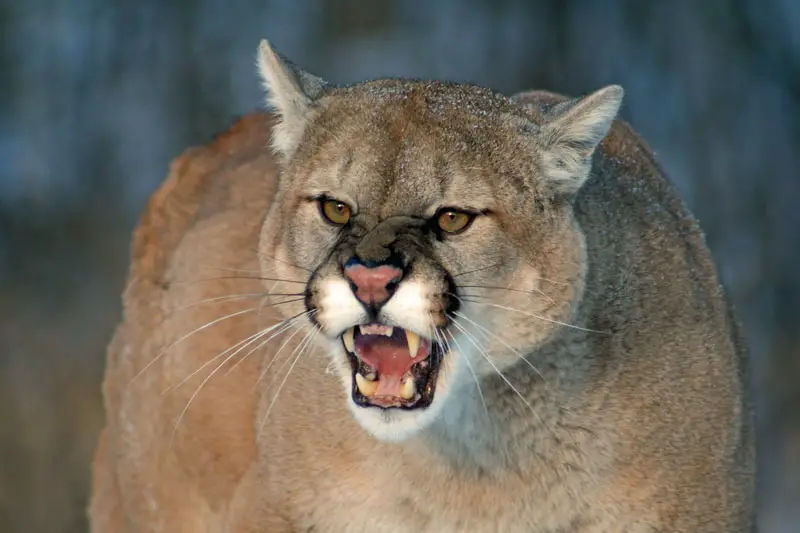Nevada has two native wild cat species that currently live in the state. They are the mountain lion and the bobcat. The Canada lynx is also native to Nevada, but wildlife officials believe that this cousin to the bobcat has been expatriated from the state.
Mountain Lions in Nevada (Puma Concolor)
Mountain lions live over a wide geographic area. Consequently, they have many regional names. In recent years, their scientific name was even changed from Felis concolor to Puma concolor. Some common names that mountain lions go by are cougar, panther painter, and puma.
A Mountain lion looks a lot like a house cat with short tan hair. Mountain lions are a lot bigger than domestic cats, though. These animals, in general, have lean, muscular bodies, rounded heads, and upright ears that are oval at the tip. Another characteristic of the mountain lion is its long, black-tipped tail, which accounts for almost one-third of its entire length. Their long tails help them keep balance.
Mountain lions have a light brown coat of short, coarse hair over most of their body. The area around their nose, the tip of their tail, and the tips of their ears are black. Their belly, the area above their upper lip, below their lower lip, and their chin are all white. They also have a sprinkling of dark hair on their backs. Bear in mind, though, that their coat color varies somewhat with geographic location.
Male and female mountain lions are phenotypically identical in every respect except for size. Males are 30 to 40% bigger than females. Though sizes vary considerably throughout the cat’s geographic range, an adult male typically weighs between 110 and 180 pounds, 50 to (82 kgs). A rare few of them grow bigger than 200 pounds (91kgs). Female mountain lions or queens average between 80 and 130 pounds (36 to 59 kgs). Adult males or toms will reach a length of 6 to 8 feet (1.8 to 2.4 M) from their snout to the tip of their tail. On the other hand, adult females are 5 to7 feet long (1.5 to 2.1 M).
Mountain lions are the fourth largest wildcat in the world. They are smaller in size only than the Jaguar in the Americas. However, worldwide, the African Lion and the Tiger are also larger.
A fun fact is that despite their large size, they are not taxonomically classified as big cats because they cannot roar. Leopards, for example, are smaller than mountain lions, but since they can roar and cannot purr, they are classified as big cats while mountain lions are not. Another interesting thing that I can mention here is that mountain lions purr.
Since they purr and cannot roar, mountain lions are in the Felis genus, while big cats that cannot purr and can roar are in the Panthera genus.
A mountain lion is a formidably tough wild animal. They can run 40 to 50 miles per hour for short bursts and jump up to 40 feet with a running start. They can also leap 15 feet vertically from a flat-footed start. See
Where are Mountain Lions Found?
Mountain lions live on all three American continents. Their range begins in the Yukon territory of Canada in the north and extends down through North, Central, and South America to Argentine Patagonia in the south.
In Canada, the biggest populations of them are in British Columbia and Alberta. On the other hand, in the United States, they mainly live in the western states and Florida. The people of Florida call this elusive cat the Florida Panther.
According to the Nevada Department of Wildlife, mountain lions live in a wide variety of habitats and conditions throughout the state. Their natural habitats include both desert and mountain country. They prefer steep rocky terrain to hide and sleep in during daylight hours. They also like areas with thick cover when hunting to stalk and ambush prey, such as pinyon pine, juniper, mountain mahogany, cold desert shrubland, and sagebrush.
With the exception of when they come together to mate or in the case of raising young, they are solitary animals. They cover a lot of country. An adult male’s home range is normally more than 100 square miles. They will sometimes mark their territory by leaving claw marks on trees. They also scratch up piles of leaves and or pine needles that they urinate on as a scent marker. Male mountain lions fight to the death sometimes to defend their territory.
The mountain lion population in Nevada is now at around 2000 of these large cats. They are an animal that usually prefers wild places. However rare the occasion might be, though, they sometimes show up in suburban and urban areas. In the Las Vegas Valley, for instance, there have been reported Mountain lion sightings at Boulder City, Mt. Charleston, and south of Henderson in the past.
What do mountain lions eat?
Mountain lions are opportunistic predators that hunt mostly nocturnally, stalking their prey, mainly deer, from behind. In Nevada, the main prey animal for mountain lions is the mule deer. On average, a mountain lion kills a deer once a week. Additionally, they consume elk, desert bighorn sheep, pronghorns, feral horses, coyotes, raccoons, birds, rats, feral pigs, porcupines, skunks, snakes, small pets, domestic livestock, and literally any other native wildlife they can catch.

Nevada bobcats (Lynx rufus)
Bobcats live only in North America. Their range begins in southern Canada, about where the range of the Canadian lynx begins to dwindle out and extends south into southern Mexico.
A bobcat is much smaller than a mountain lion. In fact, bobcats that are a little on the small side are not much bigger than large domestic cats.
A bobcat is 2 to 4 feet long and weighs about 15 to 35 pounds. A Female bobcat is quite a bit smaller than a male.
These animals have a short tail with a black tip rather than a long one. Their fur is usually gray to brown, with dark mottled spots that range from brown to black on their bodies. They also have black stripes on their inner forelegs and tail.
From a side view, you will notice that a bobcat is slightly higher in the rump than at the shoulders. Bobcats and lynx have long hind legs in proportion to their forelegs.
They have black-tufted ears. In other words, they have tufts of hair that poke up above their ears that are black at the tips. They also have a whiskered face that seems broader due to their long ruffled facial hair and whiskers. Their eyes are yellow most of the time with round black pupils.
Like mountain lions, bobcats live a solitary existence most of the time. The only time that you’d be likely to see two adult bobcats together is during the mating season. Female bobcats breed once a year. If they successfully breed, they will have anywhere from kittens. After breeding, the male’s role is complete. He goes off to search for more females to mate with. Only the female bobcat cares for the kittens and teaches them how to survive. When they are about a year old, the young bobcats are on their own.
Bobcats are fierce. If you get one cornered, you’ve got a semi-dangerous animal on your hands. It will hiss, growl and spit like one of the nastiest house cats you’ve ever run into x a million. They mean it too. They have to be tough and mean to survive.
What do bobcats eat?
Despite their comparatively small size, bobcats are aggressive, tough predators. At times, particularly during the winter, they prey on animals that are much larger than they are, such as deer. However, their regular diets mainly consist of small mammals, reptiles, birds, and carrion. When they take up residence close to a residential area, their menu might occasionally also include small domestic dogs or cats.
They even prey on rattlesnakes even though they are not immune to rattlesnake venom. They accomplish this by using their quickness to pin the snake’s head down with a paw, after which they dispatch the snake with a quick bite to its spine behind the head.
Where do bobcats live in Nevada?
As with mountain lions, the bobcat’s habitat is liberally distributed throughout the state. They do well in a wide variety of different habitats. They are at home in the mountains, in semi-desert areas, or the desert country.
Like mountain lions, bobcats are not a common sight around civilization. However, they are more apt to take up residence around residential neighborhoods than mountain lions are. Bobcats are native to southern Nevada, and they didn’t leave when all the people began moving into Clark County. They just adapted to the situation. People rarely know that they’re around until their pets start to come up missing because they seldom come out in broad daylight.

Canada Lynx (Lynx canadensis)
Canada lynx are close relatives to and consequently look a lot like bobcats. They are 1 of 6 mammalian species that formerly inhabited parts of Nevada but are now expatriated from the state. The others are the grizzly bear, the bison, the gray wolf, the wolverine, and the Arizona cotton rat. Source
Canadian Lynx closely resemble their close relative, the bobcat but with some differences. First of all, they are bigger than bobcats. They are up to 35 1/2 inches (90 cm) long and 26 inches (65 cm) tall. Additionally, they weigh up to 37 and a half pounds (17 kg).
Canadian Lynx have triangular pointed ears with black backs and long tufts of black hair on the tips. The hair tufts are much longer than a bobcat’s. They also have drooping flared facial ruff of white hair on the sides of their face beneath their chin.
Additionally, they have yellow eyes with vertical black pupils.
Lynx have long legs in proportion to their bodies, with their hind legs being slightly longer than their front ones. This gives their body a peculiar, sloped appearance.
Canadian Lynx have almost comical-looking oversized fur-covered paws. There’s a good reason for this. Their large paws function like snowshoes, allowing them to travel and hunt on top of the snow. Canadian lynx feet can keep almost twice as much weight from sinking into the snow as those of a bobcat. This is why Canadian lynx range over the deeper snow country of northern Canada while bobcats do not.
Canadian Lynx have long thick grey fur in the winter. By summertime, they have shed their grey fur and have a thinner, shorter reddish tan hair coat instead. Their color is more uniform than that of bobcats. While bobcats have black spots and mottled coloration over their entire body, Lynx are solid tan except for some mottled darker brown spots on their legs. See
According to the same article in the Elko daily free press referenced above, there are only two recorded instances of Canada lynx being seen in the history of the state of Nevada. They probably never were overly abundant in the state.
In other parts of their range, their population rises and falls with the abundance or the lack thereof of the snowshoe hare. The following is copied from another Krebs Creek Outdoors post. The link to the entire article on Canada lynx is above.
“Canadian Lynx Diet
What do Canadian Lynx eat? Mice squirrels, ptarmigan, grouse, ducks, deer, Dall sheep, and caribou make up a minor portion of a Canadian lynx’s diet. However, they have adapted to mainly prey on snowshoe hares.

Lynx and snowshoe hare
The Canada Lynx is very dependent on snowshoe hares as a food source. In some areas, hares comprise 75 percent of their total diet. In fact, their population density is directly correlated with the snowshoe hare population. Canadian and Alaskan Canadian Lynx and snowshoe hares go through what is known as the Lynx-Snowshoe Hare Cycle. When food sources are abundant for hares, their population increases very rapidly since they can have several litters per year. When hare populations are at their peak, there can be as many as 1500 animals per square kilometer” 3913 per square mile”. At this time, the population of Lynx and other predators are also at their peaks.
Since the habitat cannot provide enough resources for so many animals, and there are so many predators, the hare population crashes. When the hare population crashes, the lynx population follows suit within 1 to 2 years. This cycle repeats itself about once every ten years.
In periods of snowshoe hare scarcity, Canadian lynx switch over to red squirrels as the main food source and have been documented to travel up to 1100 kilometers (684 miles) in search of a range with a more abundant food supply.
Many Lynx don’t do as well with other food sources, particularly in winter, so malnourishment becomes a problem. Lynx that cannot adapt to other food sources die off, and females produce fewer litters of kittens. The litters that are produced have fewer kittens in them, and the kittens that are born are smaller and weaker. Most of these won’t survive to adulthood. Source
When predator numbers are low, and food is abundant, the snowshoe hare population will rebound, and so the cycle begins again.
Interestingly, snowshoe hare populations in the lower 48 states do not go through the same decennary fluctuations as in the northern latitudes. The more temperate forests don’t support such large populations, but they also don’t go through the same boom and bust cycle. Therefore, if lynx populations fluctuate, it’s for other reasons. Source Source”
The last paragraph says that lynx in the contagious 48 states don’t go through the same boom and bust cycles with the snowshoe hair population that they do in Canada and Alaska.
The decline of the lynx in Nevada might have more to do with other factors related to the settlement of the state and the utilization of its resources by settlers.
The U.S Fish and Wildlife Service is studying the possibility of reintroducing the Canada Lynx to the Jarbidge Mountains in northern Elko County.
Also, see:
Wild Cats of Texas – Krebs Creek
Wild Cats In Arizona – Krebs Creek
Recent Posts
The only venomous snakes in Washington State are Northern Pacific Rattlesnakes. The Northern Pacific Rattlesnake (Crotalus oreganus oreganus) is a sub-species of the Western Rattlesnake. Anyone...
Skunks are not classified as true hibernators. But they go into a state of torpor when the weather gets cold. Skunks are light sleep hibernators, along with opossums, bears, and raccoons. ...

